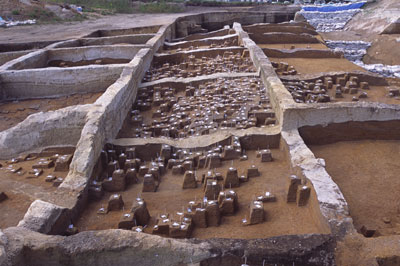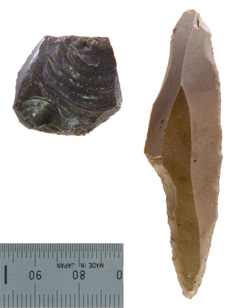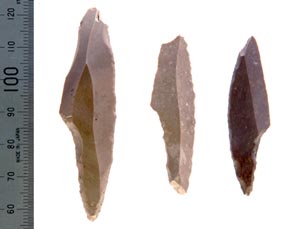Tamukai Hiyamizu:
A stone tool production site of Upper Paleolithic man. Traces of using local materials as well as stone tools brought from the outside.
 Stone tools in situ (from the east)
Stone tools in situ (from the east)
Skewers stand at points where stone tools were unearthed. The reddish brown soil is the Takadate volcanic ash layer, at approximately 2 m below the present surface. Approximately 8,000 stone tools have been recovered, but the majority are irregularly shaped stone chips of quartzite.
 Knife-shaped stone blade (right) and bipolar flake (left)
Knife-shaped stone blade (right) and bipolar flake (left)
The knife-shaped blade is thought to have been mounted on a handle and used for thrusting or slicing. Length is 6.7 cm.
The bipolar flake is also called a "wedge-shaped stone tool." As the flake is struck using bipolar percussion, setting a stone onto an anvil and hitting it with a hammer, rippled flaking bulbs are visible at both ends of the flake.







|
Tamukai Hiyamizu Site, Hachinohe City, Aomori Prefecture
Tamukai Hiyamizu is located atop a terrace of 8-20 m elevation on the left bank of the Taida river, in the southeast portion of the city of Hachinohe; from investigations conducted to present, artifacts and features of every age from the Paleolithic to the Edo periods have been discovered.
Large amounts of stone tools recovered from the upper portions of the Takadate volcanic ash layer
The recovery in large amounts of knife-shaped stone blades and other artifacts from the Upper Paleolithic period is specially noteworthy. These were distributed atop the ridge of a small tongue-shaped projection of a hill, in the uppermost regions of Takadate volcanic ash layer, directly below a thin, dark brown weathered stratum which lies nearly 2 m below the present surface. Judging from the age of the strata, these items are inferred to date from approximately 24,000 to 15,000 years before the present.
A site where local quartzite was processed
Among the approximately 8,000 artifacts of the Upper Paleolithic are knife-shaped stone blades, end and side scrapers, bipolar flakes, spalls, flakes, stone chips, and pebble tools. Stone chips are most numerous, with quartzite which could be procured locally being used. As this stone is intractable, the shapes and sizes are irregular. By contrast, more easily worked shale was used for the knife-shaped stone blades, and end and side scrapers. As shale is not readily obtained locally and limited in quantity, it is thought to have been brought in from the outside.
This is the first example of knife-shaped blades being recovered in quantity in the southern part of Aomori Prefecture, and from the results of analysis of each tool type and through comparisons with other regions, the way of life of Upper Paleolithic man should become clearer with time. (Sugiyama Yōsuke)
